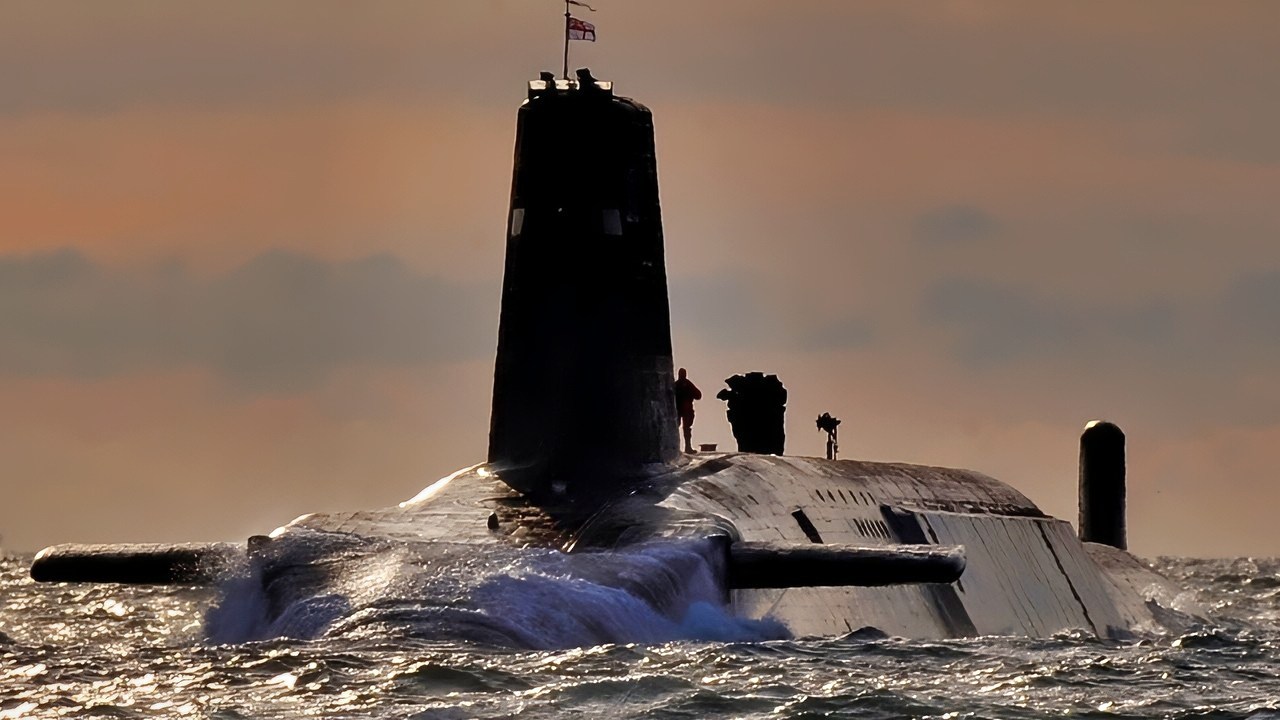Key Points and Summary – The UK Ministry of Defence has confirmed that its nuclear modernization is on track, with full funding for the next-generation nuclear warhead, Project Astraea (A21/Mk7).
-This new warhead is being developed to replace the current Holbrook and will enter service alongside the Royal Navy’s new Dreadnought-class submarines in the early 2030s.

Vanguard-Class Submarine Royal Navy Photo. Image Credit: Creative Commons.
-The Dreadnought program is also reported to be on schedule, with the first boat’s keel-laying ceremony held in March 2025.
-The new Astraea warhead is being developed in coordination with the U.S. W93 program, sharing non-nuclear components, and will be certified as reliable using advanced laser facilities and supercomputer simulations rather than live testing.
The UK’s New Dreadnought Nuclear Submarines Are On Schedule
The UK Ministry of Defence has confirmed two developments in Britain’s strategic nuclear efforts: funding for Project Astraea, the next-generation UK nuclear warhead for Trident II D5, and the state of government work to define requirements for the system that will succeed the Dreadnought-class SSBNs in the second half of the century.
Defence Minister Luke Pollard revealed information about both projects in response to recent parliamentary requisitions referencing the Strategic Defence Review 2025 (SDR 2025).
The Dreadnought class submarine program, which aims to build four new ballistic-missile submarines to replace the aging Vanguard class, is so far on schedule, with the first boat expected to enter service in the early 2030s.
That timing is significant because it fits the development window for the next-generation warhead program, Astraea (A21/Mk7), enabling Britain to maintain its continuous at-sea nuclear deterrent without disruption.
What Is Astraea and Why It Matters
The UK’s next-generation nuclear warhead, Project Astraea, will replace the Mk4A Holbrook warhead currently fitted to the Trident II D5 missiles carried by the Royal Navy’s Vanguard-class submarines.
It is being designed and manufactured by the Atomic Weapons Establishment (AWE).
The Ministry of Defence has confirmed that Astraea is fully funded as part of a 15 billion GBP nuclear investment package covering the new warhead’s development, continued sustainment of the existing Mk4A, and modernization of AWE’s facilities.

Vanguard-Class Submarine. Image Credit: Creative Commons.
The aim? To ensure that the new A21 warhead enters service alongside the Royal Navy’s Dreadnought-class submarines in the early 2030s – maintaining Britain’s Continuous At-Sea Deterrent without disruption.
Astraea is being developed in close coordination with the U.S. W93 warhead program, with the two allies sharing non-nuclear components, including the Mk 7 aeroshell casing, which determines the warhead’s size, weight, and aerodynamic properties while ensuring compatibility with the shared Trident II D5 missile system.
However, the nuclear explosive packaging itself is expected to remain entirely British, preserving the UK’s independent deterrent under the 1958 Mutual Defense Agreement and the 1963 Polaris Sales Agreement.
How Testing Works
Unlike the nuclear tests of the Cold War era, the UK no longer conducts live nuclear explosions to certify its new warheads.
Britain has maintained a nuclear test moratorium since 1991 and is a signatory to the Comprehensive Nuclear-Test-Ban Treaty (CTBT), which prohibits full-scale atomic detonations.
That means the new Astraea warhead must be proven safe and reliable without ever being detonated.
To do this, scientists from the AWE use some of the most advanced research tools in the world. The Orion laser facility, for example, is capable of reproducing the extreme pressures and temperatures found inside a nuclear explosion—up to 10 million degrees Celsius—allowing engineers to observe how materials behave under those conditions.
Theory combines these experiments with complex simulations run on a supercomputer, which models every stage of a detonation in virtual form.

Vanguard-Class Submarine From Royal Navy. Image Credit: Royal Navy.
To confirm their findings, Britain and France jointly operate the EPURE testing center in Valduc, through Project Teutates, which uses high-speed X-ray imaging to examine how components perform under stress. Together, these systems allow the UK to validate and maintain its nuclear deterrent entirely through science and simulation, without breaking international treaties or resuming testing.
Where the Dreadnought Program Stands
The Dreadnought program is the cornerstone of Britain’s nuclear deterrent.
The four-boat class, led by HMS Dreadnought, is being built by BAE Systems at Barrow-in-Furness, with Rolls-Royce providing the new PWR3 atomic reactors.
The first of the new vessels, HMS Dreadnought, is expected to enter service in the early 2030s alongside the Astraea A21 warhead.
A significant construction milestone was reached in March 2025 when the Royal Navy and BAE Systems held a keel-laying ceremony, formally beginning the boat’s final assembly phase.
Each Dreadnought will carry the Trident II D5 missile system, the same weapon currently used by the Vanguard fleet, ensuring full compatibility with both the existing Holbrook and the forthcoming Astraea warheads.
Looking further ahead, the government has already begun planning for the system that will eventually succeed Dreadnought in the second half of the century.
Early studies launched under the Strategic Defense Review 2025 are expected to examine how merging technologies such as satellite sensing and quantum detection could affect submarine stealth and survivability.
For now, officials say the Dreadnought program is on track and fully funded—something more than can be said for many U.S. programs—and its success is closely tied to Astraea’s progress.
If both stay on track, Britain will field a modernized fleet and warhead capable of sustaining the UK’s independent nuclear deterrent well into the 2060s and beyond.
About the Author:
Jack Buckby is a British author, counter-extremism researcher, and journalist based in New York. Reporting on the U.K., Europe, and the U.S., he works to analyze and understand left-wing and right-wing radicalization, and reports on Western governments’ approaches to the pressing issues of today. His books and research papers explore these themes and propose pragmatic solutions to our increasingly polarized society. His latest book is The Truth Teller: RFK Jr. and the Case for a Post-Partisan Presidency.
More Military
Nimitz-Class Aircraft Carrier USS Carl Vinson Has a Message for the U.S. Navy
The Navy’s New DDG(X) Destroyer Looks Like a Missile and Laser Machine
Germany’s Big F-35 Fighter Purchase Comes Down to 1 Word
Eurofighter Typhoon vs. JAS 39 Gripen E: Who Wins Summed up in 4 Words
JAS 39 Gripen E vs. Dassault Rafale Fighter: Who Wins in a Fight Summed Up in 4 Words










